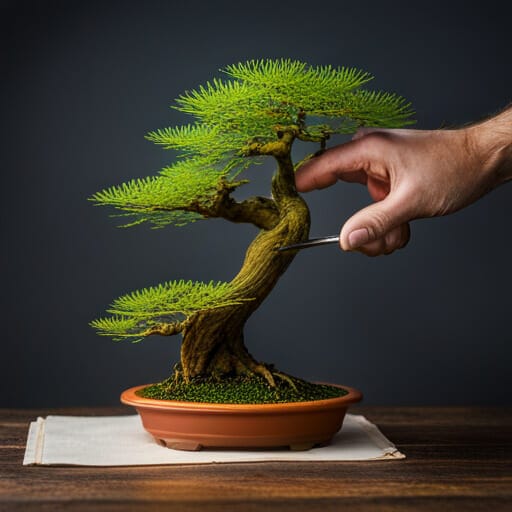In the world of horticulture, there exists a majestic tree that captivates the senses with its delicate beauty and graceful presence. The subject of our guide today is none other than the mimosa tree bonsai, a botanical wonder that embodies elegance and serenity.
This comprehensive guide aims to unveil the secrets of growing and caring for this exquisite tree, Albizia julibrissin, in a manner that nourishes both the tree and the soul of its caretaker. With its origins in China, this fast-growing tree flourishes in tropical or semi-tropical climates, requiring minimal water and basking in the warmth of well-drained loamy soil.
Whether gracing the outdoors with its vibrant blooms or adorning indoor spaces with its ethereal charm, the mimosa tree bonsai demands our attention and care. Join us as we embark on a journey of nurturing, propagation, and warding off pests and diseases, all in the pursuit of cultivating an enduring masterpiece.
Contents [show]
Quick Points
- Mimosa trees are fast-growing and have a lifespan of around 20 years.
- They prefer tropical or semi-tropical climates and well-drained loamy soil.
- Mimosa trees require full sunlight, light pruning, and a temperature of around 60°F or 15°C.
– They can be propagated through seeds or cutting stems and may face common pests like spider mites, scale, and webworms.
Ideal Growing Conditions

The ideal growing conditions for a mimosa tree bonsai include:
- Placement outdoors with a minimum of 8 hours of sunlight
- Indoors beside a window or on a balcony with partial sunlight and shade
- Crucial temperature of around 15°C or 60°F
Other important factors for their growth include:
- Proper watering and a sound drainage system to prevent waterlogged roots
- Balanced fertilizer applied once or twice a month
- Pruning and wiring in spring to maintain shape and size
- Repotting every two years using acidic to neutral soil (pH 5.0-7.5)
Mimosa trees thrive when they receive adequate sunlight, so it’s important to place them in a location that allows for at least 8 hours of direct sunlight. Indoors, they should be placed near a window or on a balcony that receives partial sunlight and shade. The temperature should be maintained around 15°C or 60°F, as this is crucial for their growth.
Proper watering is essential, avoiding overwatering and ensuring a sound drainage system to prevent waterlogged roots. Additionally, mimosa tree bonsai should be fertilized with a balanced solid or liquid fertilizer once or twice a month to provide them with the necessary nutrients.
Pruning and wiring should be done in spring to maintain their desired shape and size. Repotting is recommended every two years using acidic to neutral soil (pH 5.0-7.5) to ensure their continued health and growth.
Propagation Methods

Propagation methods for the mimosa tree involve either collecting and sowing seeds or selecting healthy stems for cutting propagation, both of which require specific techniques and timing.
When propagating through seeds, it is recommended to collect them in autumn and soak them in hot water for 24 hours before sowing.
On the other hand, cutting propagation should be done in late spring by selecting a healthy stem, removing the leaves, and rooting it in a soil mixture with hormone rooting powder.
It is important to ensure proper care and maintenance during the propagation process to increase the chances of success.
By following these techniques, gardeners can effectively propagate mimosa trees and enjoy the beauty of these bonsai specimens in their gardens or indoor spaces.
Pests and Diseases

Pests and diseases commonly affecting the mimosa tree include spider mites, scale, and webworms. These pests can cause significant damage to the tree if not properly managed.
Spider mites are tiny insects that feed on the leaves, causing yellowing and stunted growth. Scale insects, on the other hand, attach themselves to the bark and suck sap from the tree, leading to weakened branches and foliage. Webworms are caterpillars that create silken webs on the branches and feed on the leaves, resulting in defoliation.
To control these pests, regular monitoring is crucial. Insecticidal soaps or horticultural oils can be used to treat spider mites and scale. Pruning affected branches and removing webworms by hand can help manage their populations. It is important to maintain a healthy growing environment and promptly address any pest or disease issues to ensure the well-being of the mimosa tree bonsai.
You Might Be Interested In Our Guide for Caring For Willow Tree Bonsai
Frequently Asked Questions
How long does it take for a mimosa tree bonsai to reach its full size?
The time it takes for a mimosa tree bonsai to reach its full size depends on various factors such as growing conditions, pruning, and care. However, on average, it can take several years for a mimosa tree bonsai to reach its full size.
Can a mimosa tree bonsai be kept indoors all year round?
Yes, a mimosa tree bonsai can be kept indoors all year round. It requires a location near a window with partial sunlight and shade. Maintaining a temperature around 15°C or 60°F is crucial for its growth and well-being.
Can a mimosa tree bonsai tolerate cold temperatures?
Yes, a mimosa tree bonsai can tolerate cold temperatures. It prefers a temperature of 60°F or 15°C, but it can withstand colder temperatures as long as it is protected from frost and freezing conditions.
How often should I fertilize my mimosa tree bonsai?
Fertilizing a mimosa tree bonsai is crucial for its growth and health. It is recommended to use a balanced solid or liquid fertilizer once or twice a month, ensuring proper nutrition without overfeeding.
Is it necessary to prune the roots of a mimosa tree bonsai during repotting?
Pruning the roots of a mimosa tree bonsai during repotting is not necessary. However, it can be beneficial to trim any excessively long or damaged roots. Care should be taken to avoid cutting too much, as it may harm the tree’s overall health.




